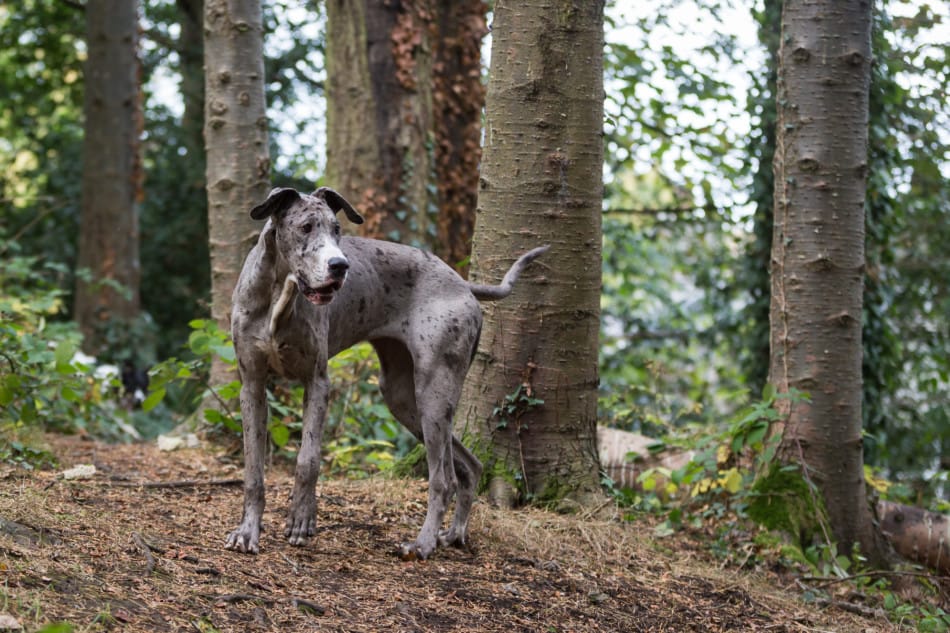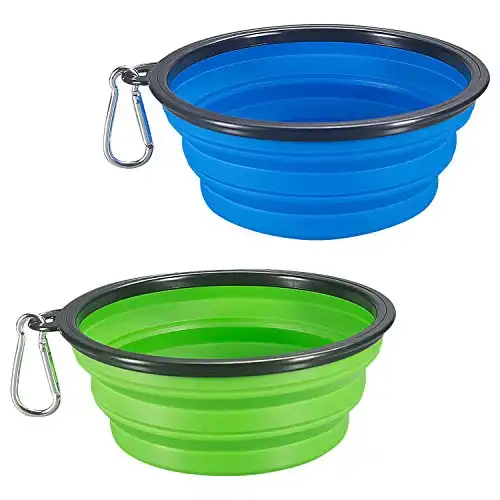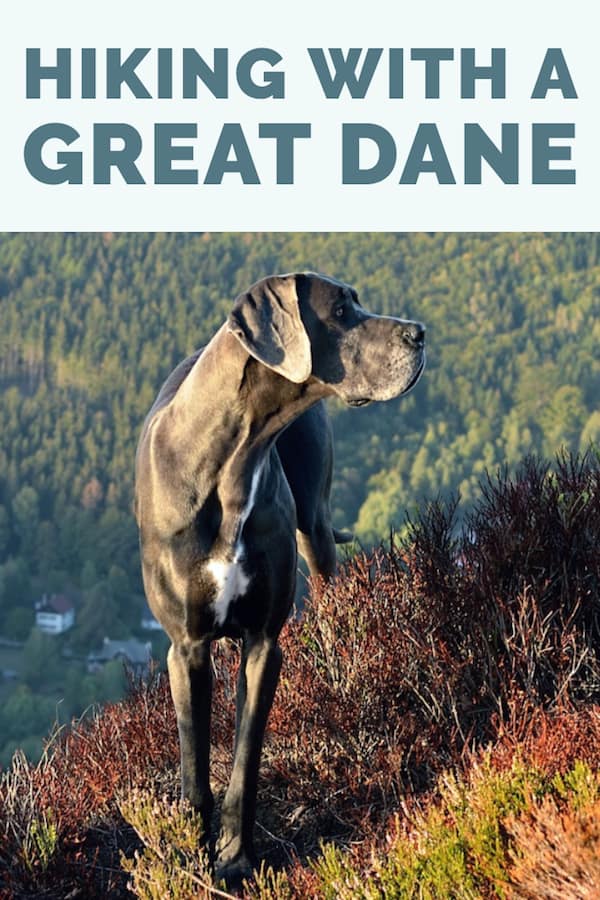
Hiking is a great way for you and your Great Dane to stay in shape and enjoy the wonderful outdoors. Before you jump right into the car and head for the trail, take a few minutes to review the tips below to make sure your hikes are both enjoyable and safe!
If you prefer to watch a video version of these tips, we cover some of them in the YouTube video shown below.
1. Take frequent breaks
You arrive at the trailhead, jump out of the car with your Dane, and start flying up the trail! Next thing you know you’re both completely winded and gasping for breath before reaching your destination.
In the midst of all this hike excitement, make sure to take frequent breaks to give yourselves time to rest.
These can be as short as a couple of minutes before continuing on but will go a long way in ensuring your overall hike endurance.
Try to take your breaks in shady areas if it’s a hot day, or has lots of sunlight.
2. Hydrate hydrate hydrate
As I’m sure you’re already aware, Great Danes can drink a lot of water! Make sure to bring plenty of water for you and your Dane on the hike to avoid dehydration.
While you can easily sip from a water bottle while hiking, use breaks as the opportunity to provide your Dane with a little water.
It’s better to give them a little water with each break rather than having them work up a thirst and try to gulp down a whole bowl at once later one. Not to mention the fact that your pack will get lighter with each break 🙂
We really enjoy using collapsible bowls on hikes for sharing water to our Great Dane. This allows us to bring a single large water bottle that we drink from, or pour into the collapsible bowl for our dog.
This silicone bowl is perfect for on-the-go water and food needs! It's collapsible nature makes it easy to store and transport.
They’re very lightweight and take up next to no room in a backpack. We’ve had some last us several years now and have proven to be quite a good investment.
For shorter hikes, you can also consider using a dog-friendly water bottle. Its flip-top makes for an all in one water carrier and bowl that’s also convenient.
The biggest downside is that you probably will not want to also drink out of it after Fido has had their turn
3. Build up to longer hikes
Much like us, our Danes need to build up their hiking endurance and stamina. While you may already be an endurance beast, your giant dog likely won’t be ready to handle long hikes from the get-go.
Start with short hikes and gradually extend the distance. This gives them a chance to build up their own physical endurance and their body’s time to adapt.
If you’re hiking on rougher terrain, the pads of their paws, in particular, will take time to toughen up. Dog booties can be particularly helpful for extra rough terrain to avoid bad cuts and scrapes.
Believe me when I say that having to carry your Dane with an injured paw for a couple of miles may be the biggest physical challenge of your life!
4. Respect park regulations
If you’re taking the time to read this article, then it’s probably safe to say this isn’t an issue for you but it still needs to be said. Please respect the regulations set in place by the parks you visit.
That begins with only taking your dog to parks that allow them. While it may not seem fair that dogs aren’t allowed in every park the rules are in place for a reason.
From protecting fragile environments, endangered species, or preventing waste accumulation, there are many reasons that they may not be allowed and it’s not up to us to question them.
Secondly, please comply with leash regulations in parks. There are already enough parks that don’t allow dogs at all, and failing to comply with leash rules will only lead to more parks not allowing dogs.
This includes not only keeping your dog on a leash, but also the use of proper length leashes. If the rule is a 6-foot maximum leash, your 20-foot trainer isn’t going to cut it.
5. Bring poop bags
Along with leash rules, every park that I’ve been to also requires that you bag your animals waste and dispose of it in the designated areas.
While some parks are kind enough to supply poop bags, there’s no guarantee that they’ll be in stock during your visit so make sure to bring a few of your own.
Notice that I say bring a few as my Danes never fail to poop more than once our hikes!
Bringing your own bags also guarantees that your giant dog’s poop fits in the bag.
6. Proper ID
Because many parks require dogs to be on-leash it’s likely that they’ve already got a collar on them but you should want to ensure that the collar has up-to-date ID tags on it.
These should contain your contact information in the event that you’re separated, as well as any required vaccination tags e.g. rabies.
Take the time to ensure that the collar is also properly fitted to their neck to avoid it slipping off. For parks that require entry and/or pet fees, make sure to carry proof of payment if required by the park.
7. Check the weather beforehand
Make sure to check the weather before leaving home. A hiker’s worst nightmare is getting stranded somewhere remote in a bad thunderstorm or other dangerous conditions.
Luckily, this can be prevented by checking the weather conditions in advance.
If it’s going to be particularly hot, consider bringing more water than you normally would. For cold conditions, consider bringing extra layers both for yourself and your Dane.
We live in Colorado, and make sure to bring a sweater for our Dane if it’ll be particularly cold or windy.
8. Don’t forget a trail map
Unless you know an area extremely well, make sure to bring a trail map!
Getting lost in the outdoors can lead to serious consequences and potentially be very costly in the event that emergency search and rescue assistance is required.
Let’s keep the journey pleasant by bringing a map and avoiding any Homeward Bound scenarios!
9. Strong recall
For parks that do allow for off-leash access, make sure that your Great Dane has a fantastic recall. There should be no doubt that your dog will immediately return to you when called.
While this may not be a big issue in a fenced off-leash dog park, out on the trail it is very serious. They could fall and injure themselves, slide down a ravine or other hard to escape area, etc…
In the wilderness, it’s also very likely that they could encounter wildlife. Should they have a strong prey drive and choose to chase the wildlife there’s no saying where they could end up leading to our next tip…
10. Be mindful of wildlife
Because the average Great Dane is well over 100 pounds it’s unlikely that they’ll be attacked by (most) wild animals. However, that doesn’t mean that an attack is impossible or that you shouldn’t remain mindful of wildlife.
As previously mentioned, Danes with a strong prey drive may take to chasing wildlife. Not only could this prove dangerous, but disturbing wildlife is a common reason that dogs are banned from parks.
Please respect wildlife and help keep your dog safe by not allowing this to happen.
11. Proper trail etiquette
Many parks have narrow trails and a little trail etiquette will go a long way. Allow faster-moving groups to pass by standing to one side of the trail and having your Great Dane sit by your side, therefore allowing the other group to easily pass.
Doing the same for groups passing in the opposite direction will also be much appreciated as Danes can take up quite a lot of trail space!
This is especially helpful when passing / being passed by groups who also have a dog.
There’s no saying how unfamiliar dogs will react to being forced to pass in close quarters to your giant dog, so by moving them off to the side you can help prevent unwanted bad encounters.
12. Check for ticks
If you’re going to be hiking in tick-prone areas, make sure to do a quick tick check after the hike. Lucky for you, a Great Dane’s short coat makes it very easy to locate ticks compared to other longer haired breeds.
Ticks can lead to a variety of diseases, and it’s best to remove them as quickly as possible. Lyme disease and Rocky Mountain Spotted Fever are two of the best-known diseases commonly transmitted through tick bites.
Keeping your Great Dane up to date on their flea and tick medicine is another great preventative measure that you should already be performing.
13. Pack a first aid kit
Even for short hikes, packing a small first aid kit is a great idea. You never know when you or your Great Dane could clip and cut themselves.
A basic kit can be very small and should include antiseptic wipes, antibacterial ointment, gauze pads, and an adhesive bandage.
14. Let them help carry the load
If you’re worried about weight from carrying all of these things then you’re going to be happy about this one! Your Great Dane is a very strong and able canine, and there’s no reason they can’t help you carry some of the supplies.
Much like getting started with hiking, you’ll want to gradually increase their pack carrying duties. Initially, this will start with simply getting used to wearing the pack.
From there you can slowly increase the weight and bulk of items you place in it. This could be their collapsible bowl, water bottles, snacks, or extra clothing.
We really like the Pettom dog saddle backpack because of its expandable size and large carrying capacity. The large version fits a chest size of 29 to 41 inches, so your Great Dane should be able to wear it from around 6 months of age all the way into adulthood.
Outward Hound makes smaller versions that would be a good option for younger Danes, but because they’re going through such rapid growth at this time it’s best to not place too much extra load on them (if any at all).
15. Bring a towel
If there’s even a hint of mud or water my Danes seem to find them every time! For this reason it’s a fantastic idea to keep a towel (or towels) in your vehicle so that you can wipe them down before heading home.
If it’s cold they can also use the towels for extra insulation to snuggle with while the car warms up.
16. Don’t forget the extra food!
If you plan to spend a whole day out hiking then I’m sure you’ve also some plans on what you’re going to eat.
Make sure to not forget your Dane and bring along an extra meal or two for them so that they’re not left both worn out and hungry post-hike.
The collapsible bowls are great not just for water but also for sneaking in meals.
17. Know you and your dog’s limitations
Last but not least, know you and your dog’s limitations. While conquering that distant peak might seem like a great idea, getting each of you home safe and sound is always more important.
Great Danes love their humans, and will likely try to follow them to places that they are physically ill-equipped for.
Keep your Great Dane safe by keeping them away from dangers such as vertical climbs or drops and extreme weather conditions.
For more details about where you can take your Great Dane hiking, I’d recommend taking a look at Jenny Wolf’s site HaveDaneWillTravel.com. She has done a fantastic job of putting together detailed reviews of dog friendly parks, and all kinds of tips related to traveling with a Great Dane.



Thank you for this! I’m new to hiking and new to Great Danes as well. My dog is 6 months old and I want her to enjoy every hike I go on. This is a great start.
Have fun out there!
Thank you I go to your website all the time I ordered your book as well .
I have 3 little dogs there seniors, but get my first Great Dane in a few weeks
Thanks
Thank you for the suggested brand of hiking pack!